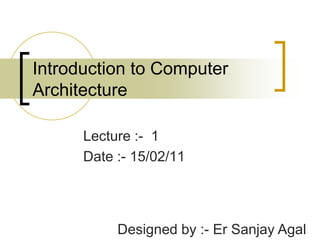
Intro comparch
- 1. Introduction to Computer Architecture Lecture :- 1 Date :- 15/02/11 Designed by :- Er Sanjay Agal
- 2. What is binary? We use the decimal (base 10) number system Binary is the base 2 number system Ten different numbers are used in base 10. How many are used in base 2? Designed by Sanjay Agal
- 3. Bits & Bytes kilo, mega, and giga are different in binary! bit (b) – binary digit Byte (B) – 8 binary digits KiloByte (KB) – 210 bytes MegaByte (MB) – 220 bytes GigaByte (GB) – 230 bytes Designed by Sanjay Agal
- 4. Storage Scam! Example: iPod Nano 8GB Designed by Sanjay Agal
- 5. What is computer architecture? What does “architecture” mean? Layout and interactions of a computer system What is a computer system? Input Process Output Can a computer system be more than one computer? Think of an example... Designed by Sanjay Agal
- 6. Major Components of a Computer Central Processing Unit (CPU) Random Access Memory (RAM) Hard Drive / Disk Designed by Sanjay Agal
- 7. ON-OFF-ON-ON 1 0 1 1 Several ways to remember the state of a switch: Electrical – RAM, flash memory Magnetic – Hard drives, magnetic tapes Optical – CDs, DVDs Designed by Sanjay Agal
- 8. What does memory look like? Memory ~ RAM Looks like a table Address and Data Address is the location Data is the actual value Memory stores both data and assembly instructions Designed by Sanjay Agal
- 9. Central Processing Unit (CPU) Also called the “chip” or “processor” The brain of the computer Major components: Arithmetic Logic Unit (ALU) calculator Control unit controls the calculator Communication bus systems What’s a bus?!? Address Bus Control Unit Memory ALU Data Bus Designed by Sanjay Agal
- 10. Fetch-Execute Cycle Fetch instruction from memory Decode instruction in control unit Execute instruction (data may be fetched from memory) Store results if necessary Repeat! Address Bus Control Unit Memory ALU Data Bus Designed by Sanjay Agal
- 11. Registers Temporary storage containers used inside the CPU Extremely fast Fixed size, usually multiples of 8-bits Also called a “word” Example: 32-bit machines (4-byte words) How large is a word in a 64-bit machine? Designed by Sanjay Agal
- 12. Cache Slower than registers Faster than RAM Located in front of main RAM Different levels of cache Level1 (L1) and Level2 (L2) Size is usually around 1 MB Designed by Sanjay Agal
- 13. Memory Hierarchy Designed by Sanjay Agal
- 14. Virtual Memory What if a program is too big for RAM? If a program is too big for memory (RAM), then we start using the hard drive (disk) to store data Designed by Sanjay Agal
- 15. Hard Drives Designed by Sanjay Agal
- 16. CD/DVDs Lands and pits used to represent binary Optical medium - lasers and refraction used to read lands and pits Designed by Sanjay Agal
- 17. Direct Access also known as “random access” No need to go through other data to get the data you want We already know where the data is, so we just get it “Magic data retrieval” – no movement/motion Example: registers, cache, RAM Designed by Sanjay Agal
- 18. Sequential Access also known as “serial-access” Data is ordered in some sequential fashion To get to your data, you need to go through other data in front of it Example: Fast-forwarding through a tape to get to the song you want Designed by Sanjay Agal
- 19. Direct-Access vs. Sequential Access Direct-Access: Advantage: fast access Disadvantage: data cannot be accessed in sequential or sorted order Data is placed randomly on the disk Accessing things in order then requires an index file Slower when trying to access sequential data that is not already in order (back-and-forth-and-back-and-forth) Example: hard drives (disks) Sequential Access Advantage: Simple to organize (already in some sequential order) Disadvantage: Slow when accessing specific things in no order Example: magnetic tape backups Could we implement sequential access using a hard disk? Designed by Sanjay Agal
